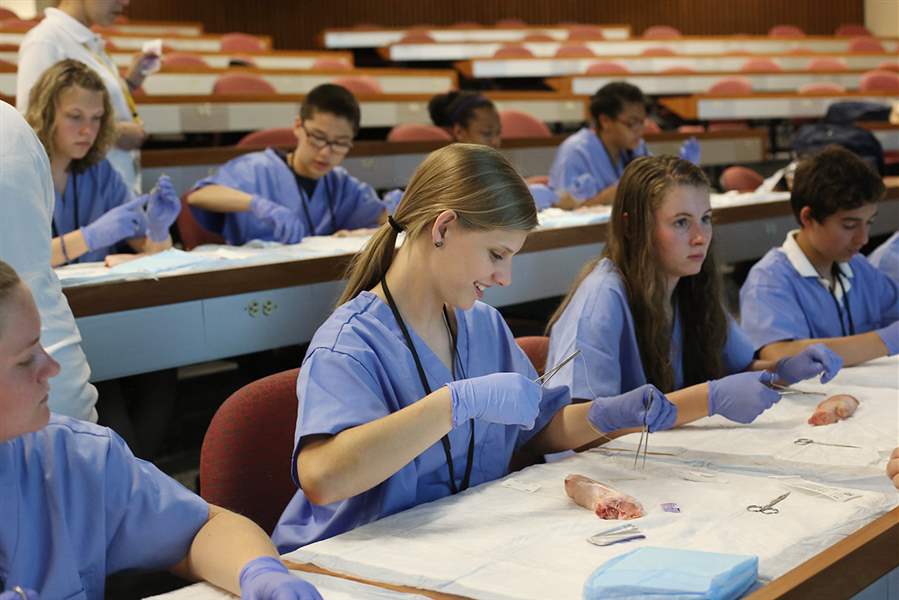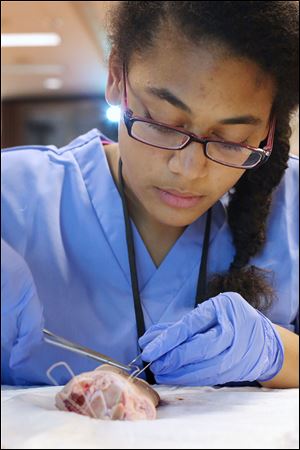
Students are taught introductory steps to a career in health
6/21/2014
Chole Lammers, 14, of Miller City, center, practices suturing a pig’s foot during class at the University of Toledo’s Health Science Campus, the former Medical College of Ohio. This was the 17th year of UT’s annual CampMed program. Forty-five students going into ninth grade participated this year.
THE BLADE/KATIE RAUSCH
Buy This Image

Chole Lammers, 14, of Miller City, center, practices suturing a pig’s foot during class at the University of Toledo’s Health Science Campus, the former Medical College of Ohio. This was the 17th year of UT’s annual CampMed program. Forty-five students going into ninth grade participated this year.
Two rows of students in blue scrubs watched Dr. Matt Goodwin stitch a pig foot Friday in the University of Toledo Health Education Building.
The rising ninth-grade students from northwest Ohio had gathered for the 17th annual University of Toledo free CampMed program to see what it means to be a medical professional. Wearing stretchy plastic gloves, they picked up needles and thread and bent over the fleshy trotters on the tables.
Most of the 45 students are the first prospective college students in their families, said Kathy Vasquez, director of the UT Area Health Education Center. Students from largely rural and economically disadvantaged communities spend two days doing everything from touring the UT Medical Center’s trauma center to performing virtual dissections with 3-D glasses.
Each student is admitted to the program based on a teacher nomination, a letter of recommendation, and an essay.
Alexis Christon, 14, arrived from Upper Scioto Valley Middle School, in McGuffey, because she wants to be a family doctor or a nurse.
The highlight of her time was an anatomy lesson with a pair of cadavers and a brain, because she got “to see what’s inside of me,” she said.
One of seven participants who will be attending Toledo Early College High School next year, Quadria Triplett, 14, said one of the most memorable parts of the program was learning how to insert a breathing tube into a model.

Alexis Christon, 14, came to the program from Upper Scioto Valley Middle School.
“I care about people, and if they’re hurt,” said Quadria, who wants to be a pediatrician. But the tasks the CampMed students face are not so easy: she managed to position the tube correctly on only one of three attempts.
Counselors enrolled at the UT Medical Center, the former Medical College of Ohio, assist the three teenage groups, which are playfully named erythrocytes, leukocytes, and thrombocytes, after the cells of the body.
According to Melissa Straub, a third-year medical school student, the program helps students who may have had minimal science training decide whether medicine is right for them. While tasks such as creating arm casts and interviewing mock patients are straightforward enough, looking at rows of preserved organs is not every child’s cup of tea.
“It has either opened or closed their eyes to medicine,” Ms. Straub said of the program.
Yet since its start in 1998, the CampMed program has reported high numbers of students who enter medical fields, according to a 2013 survey of a fourth of the group’s alumni.
Three-quarters of the respondents between 18 and 23 were enrolled in a science major at college. More than 60 percent of those older than 23 were working in a health-related career, Ms. Vasquez said.
Contact Maya Averbuch at: maverbuch@theblade.com, 419-724-6522, or on Twitter @mayaaverbuch.